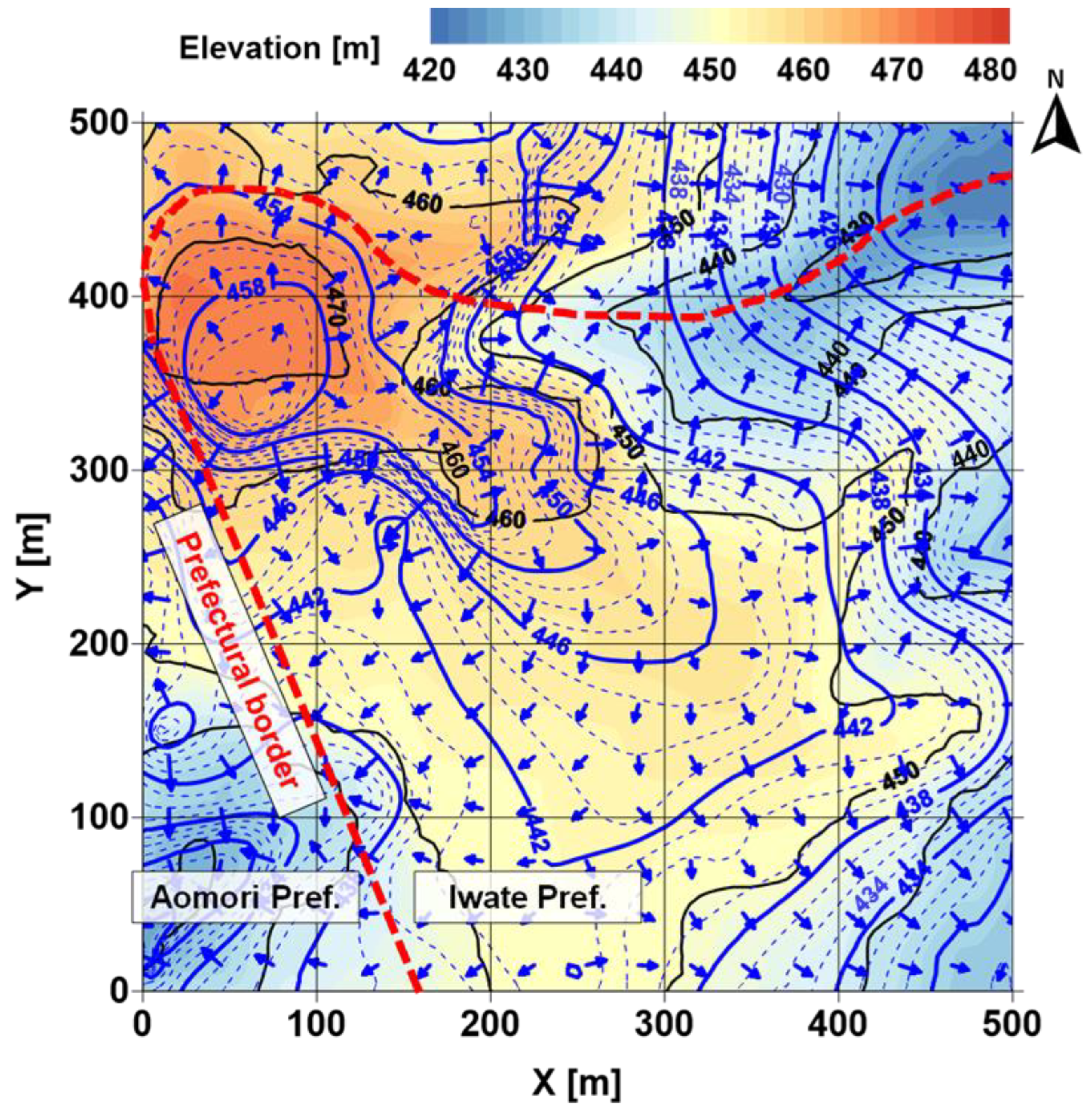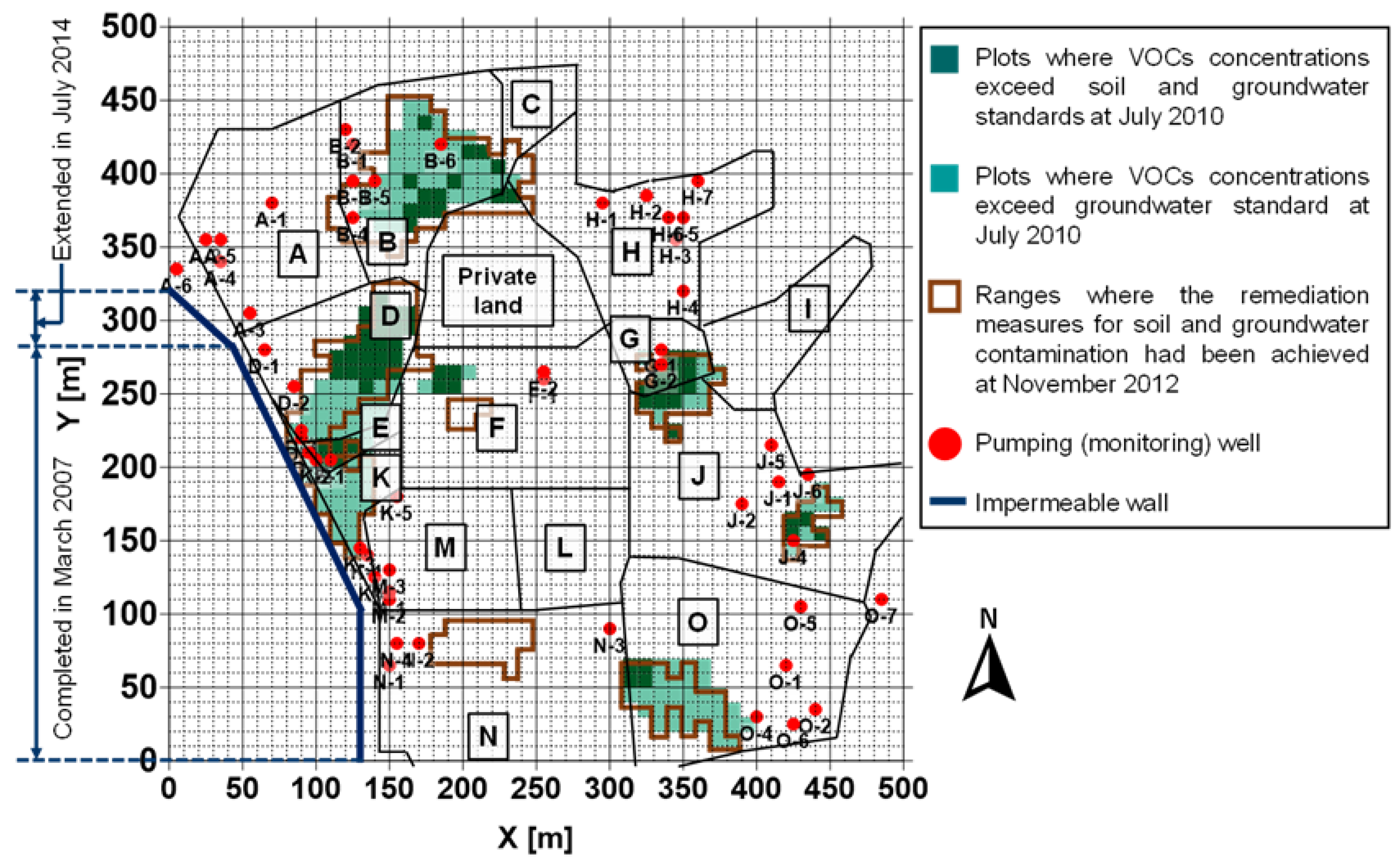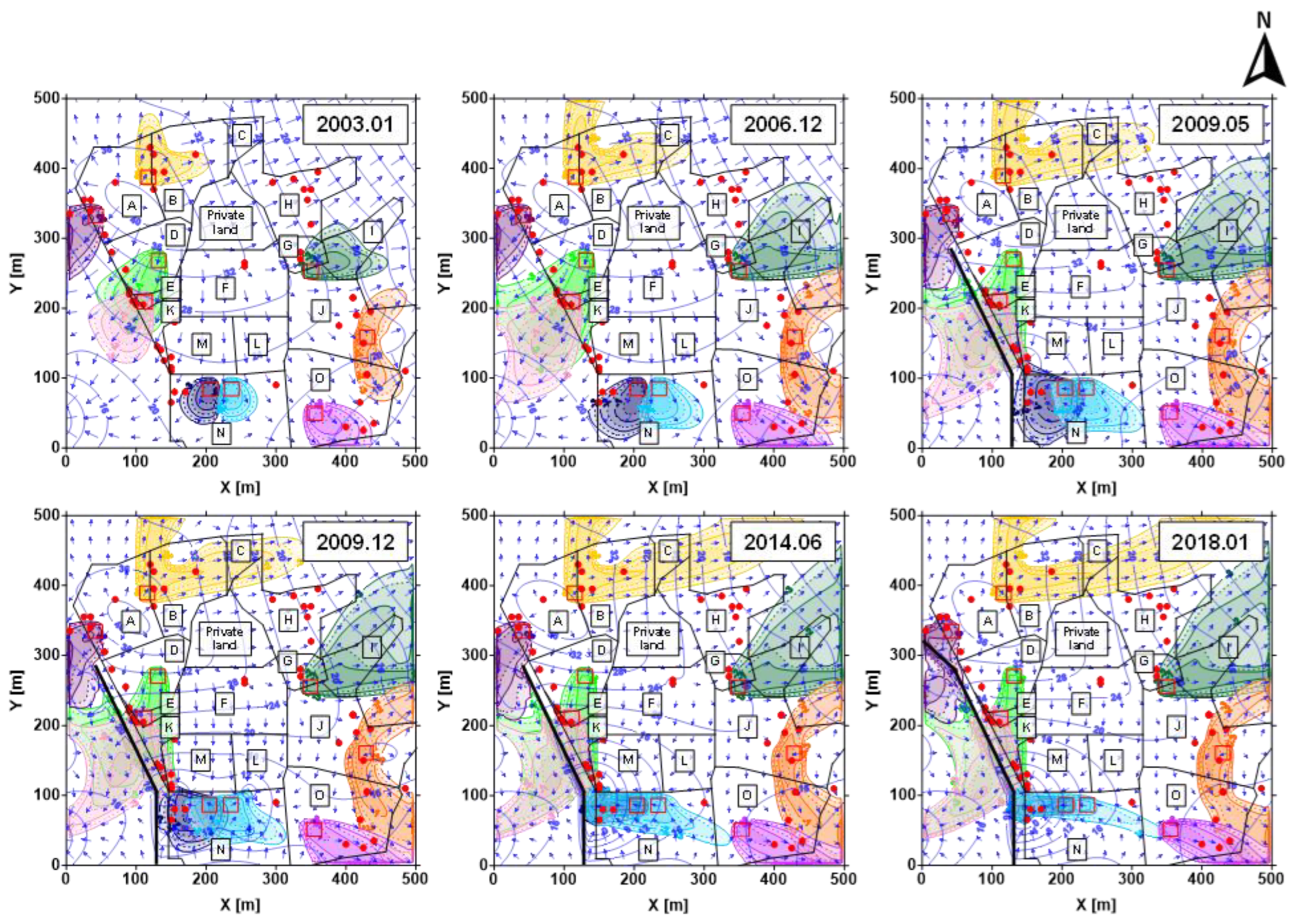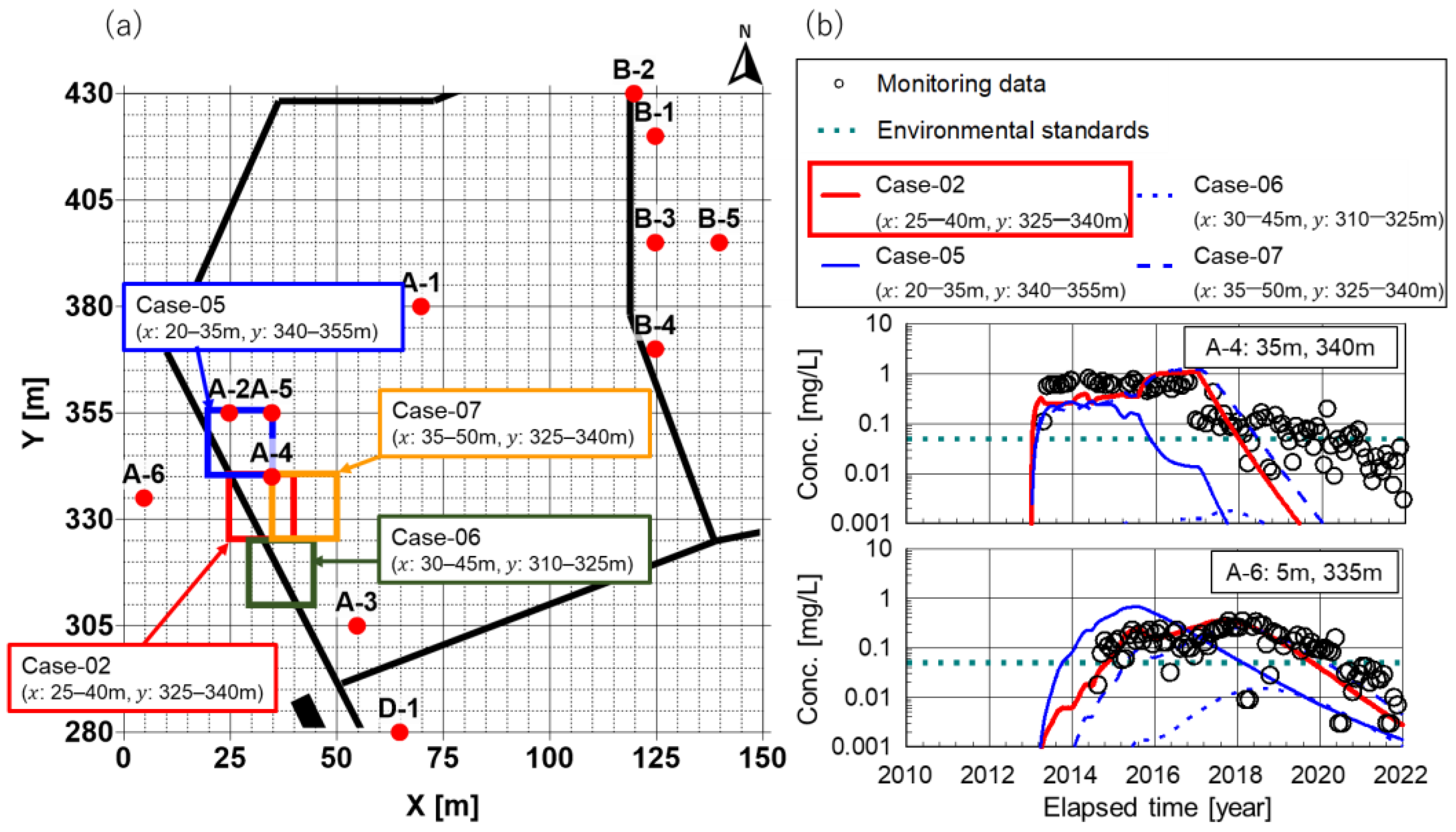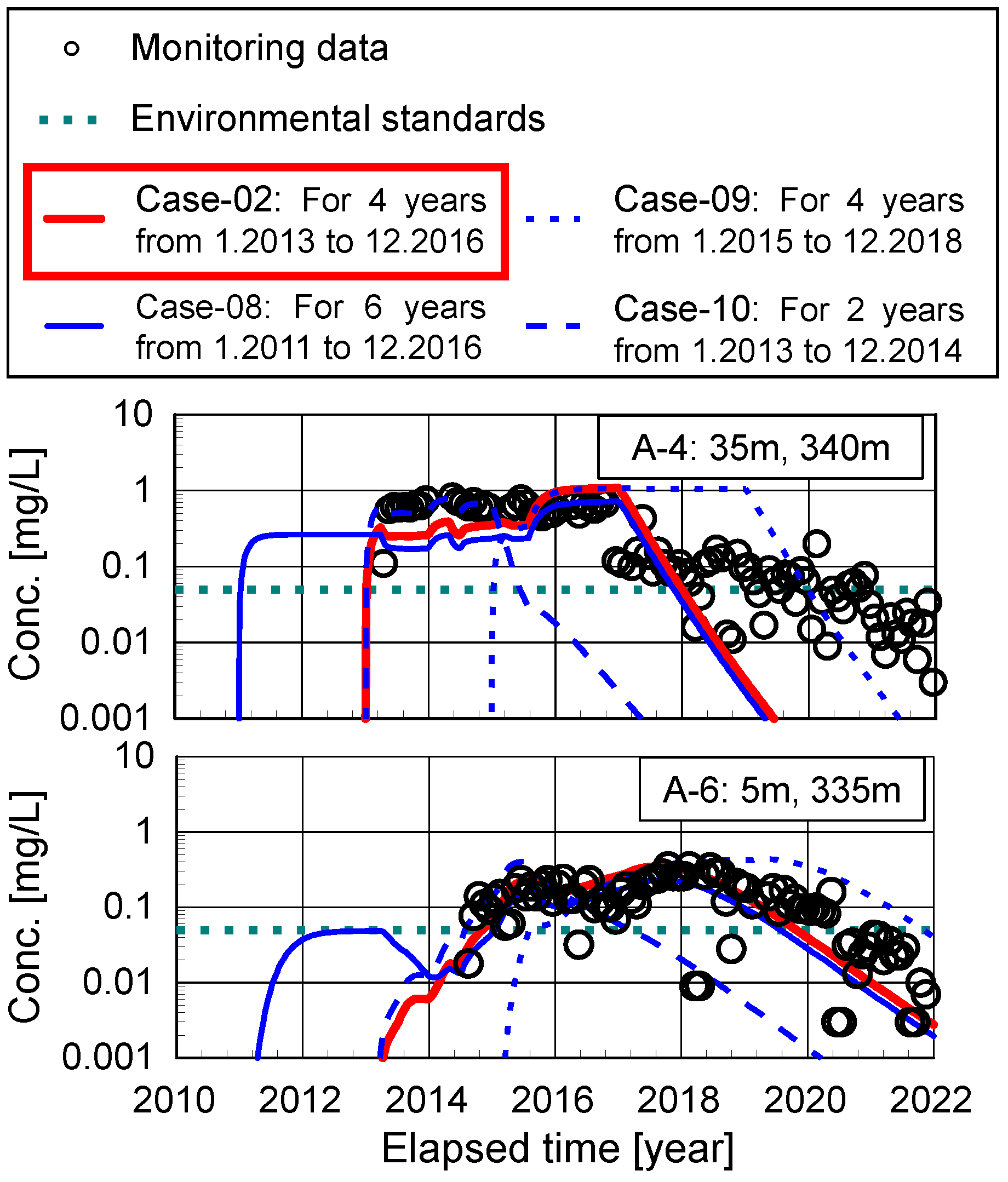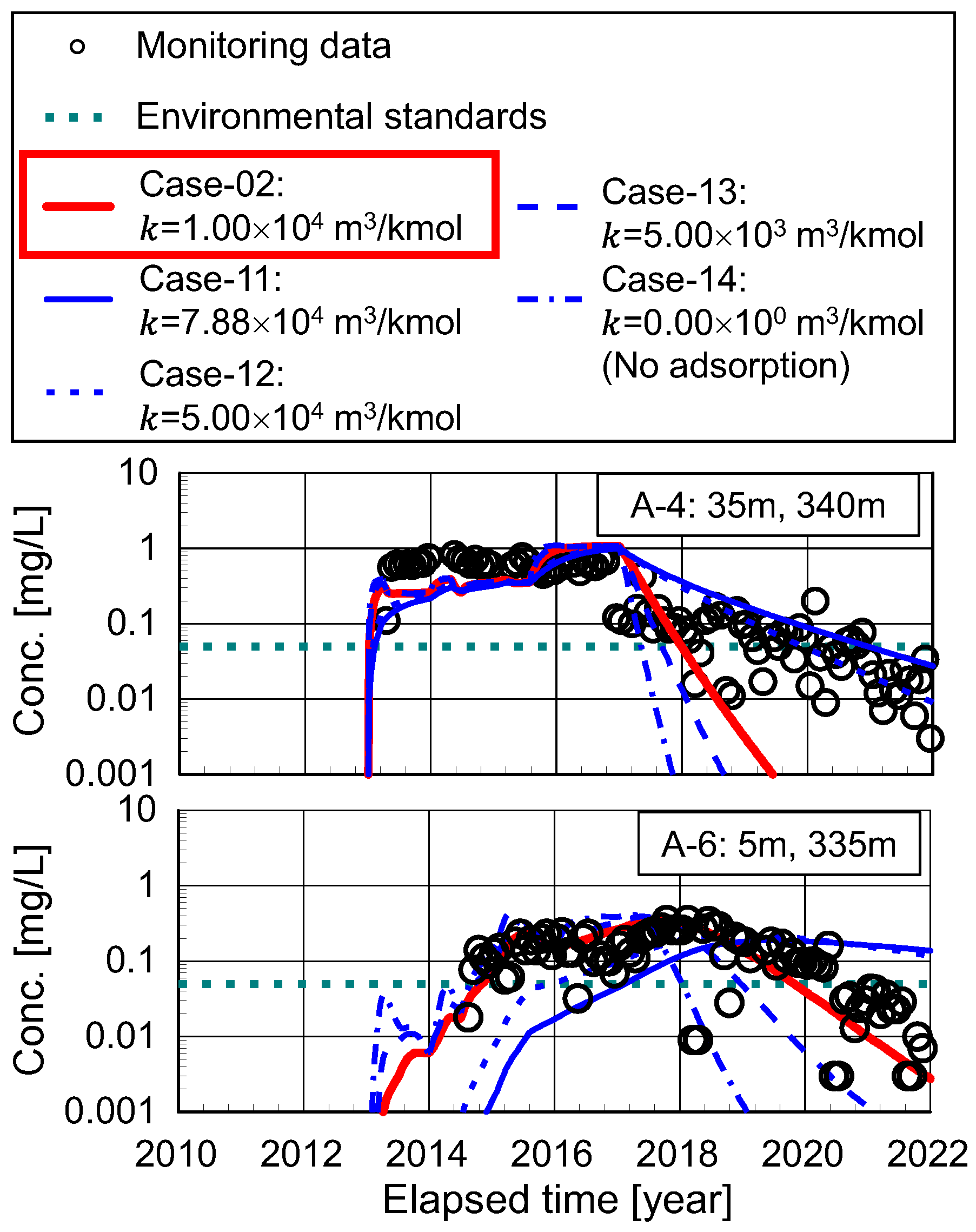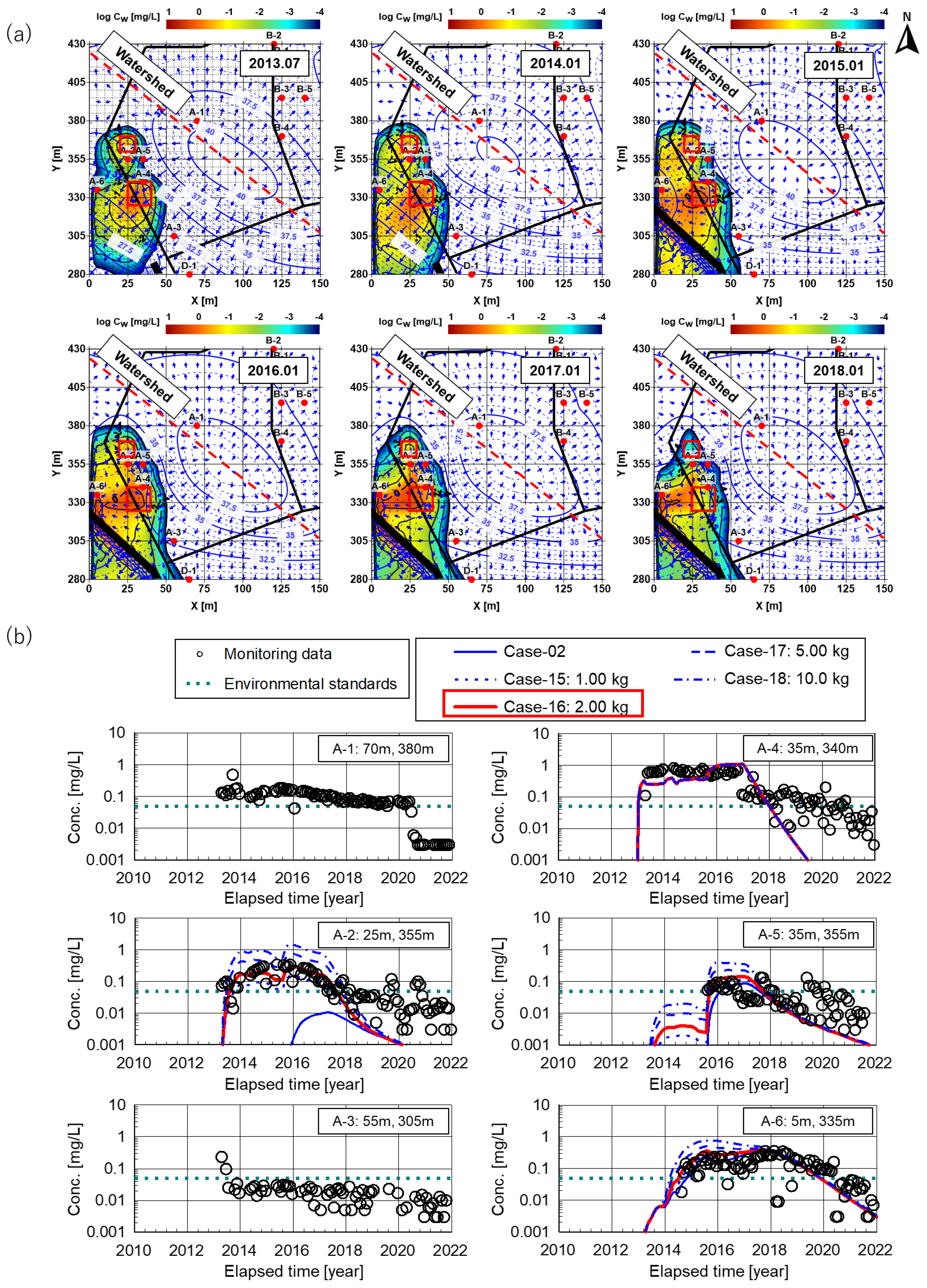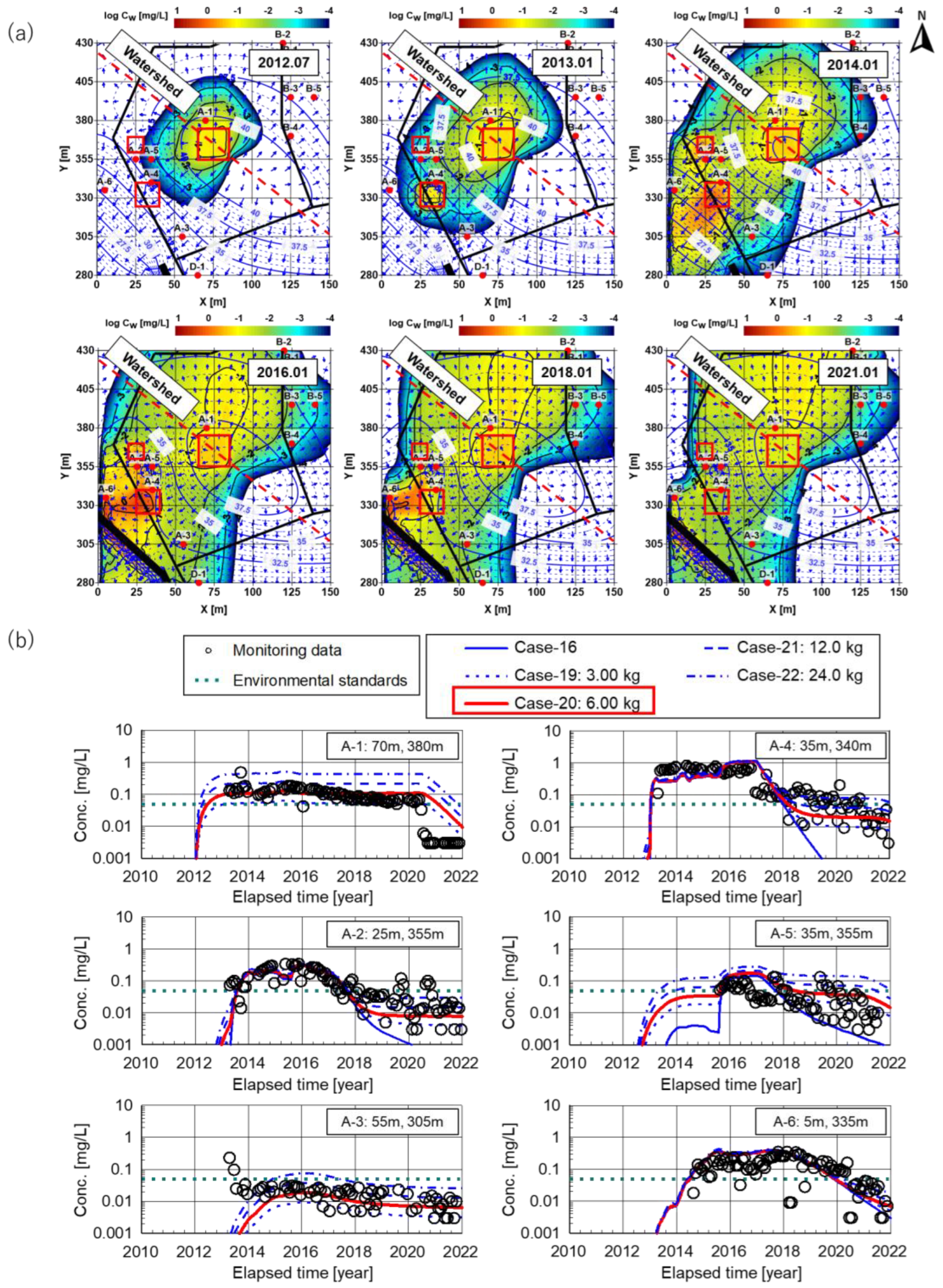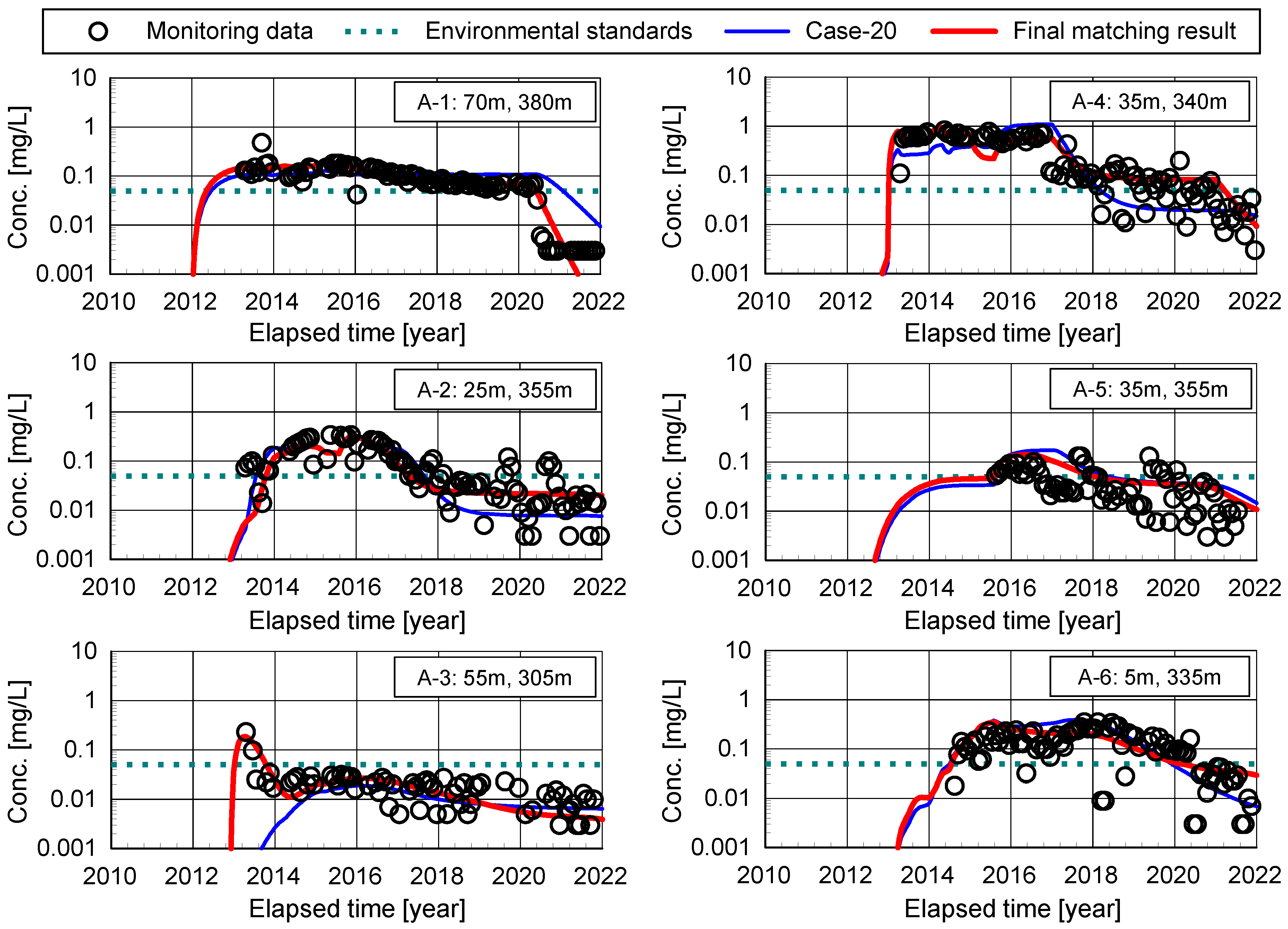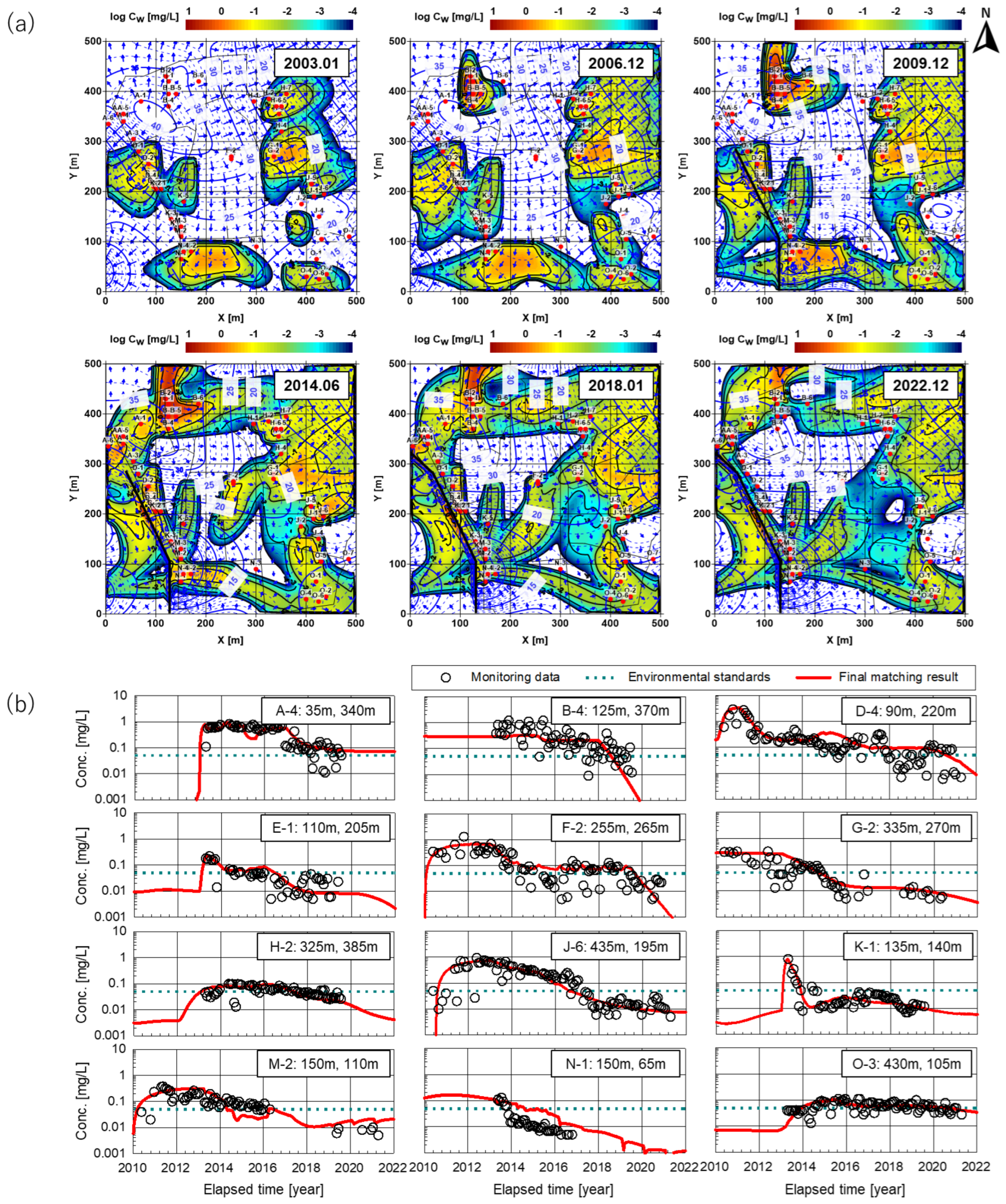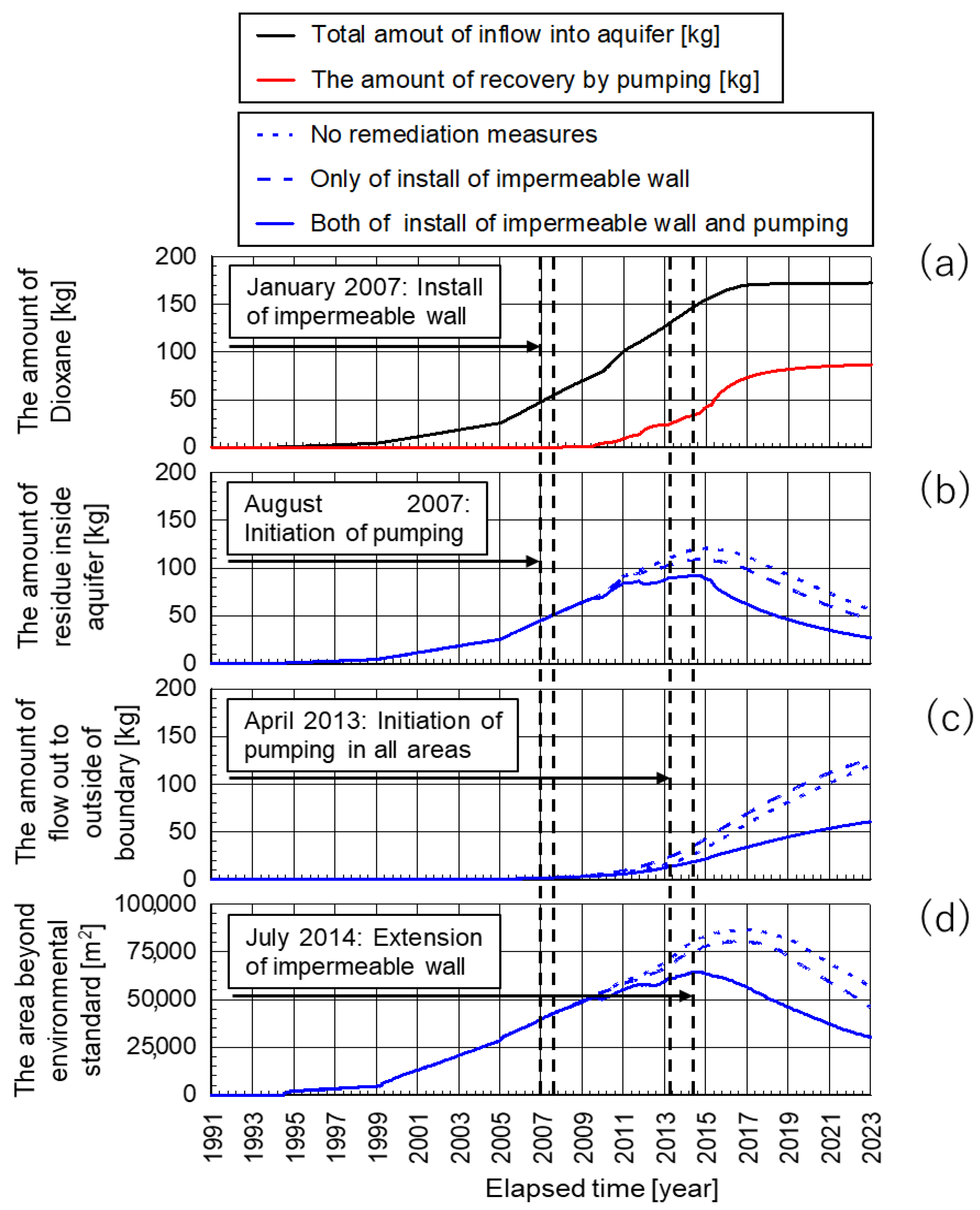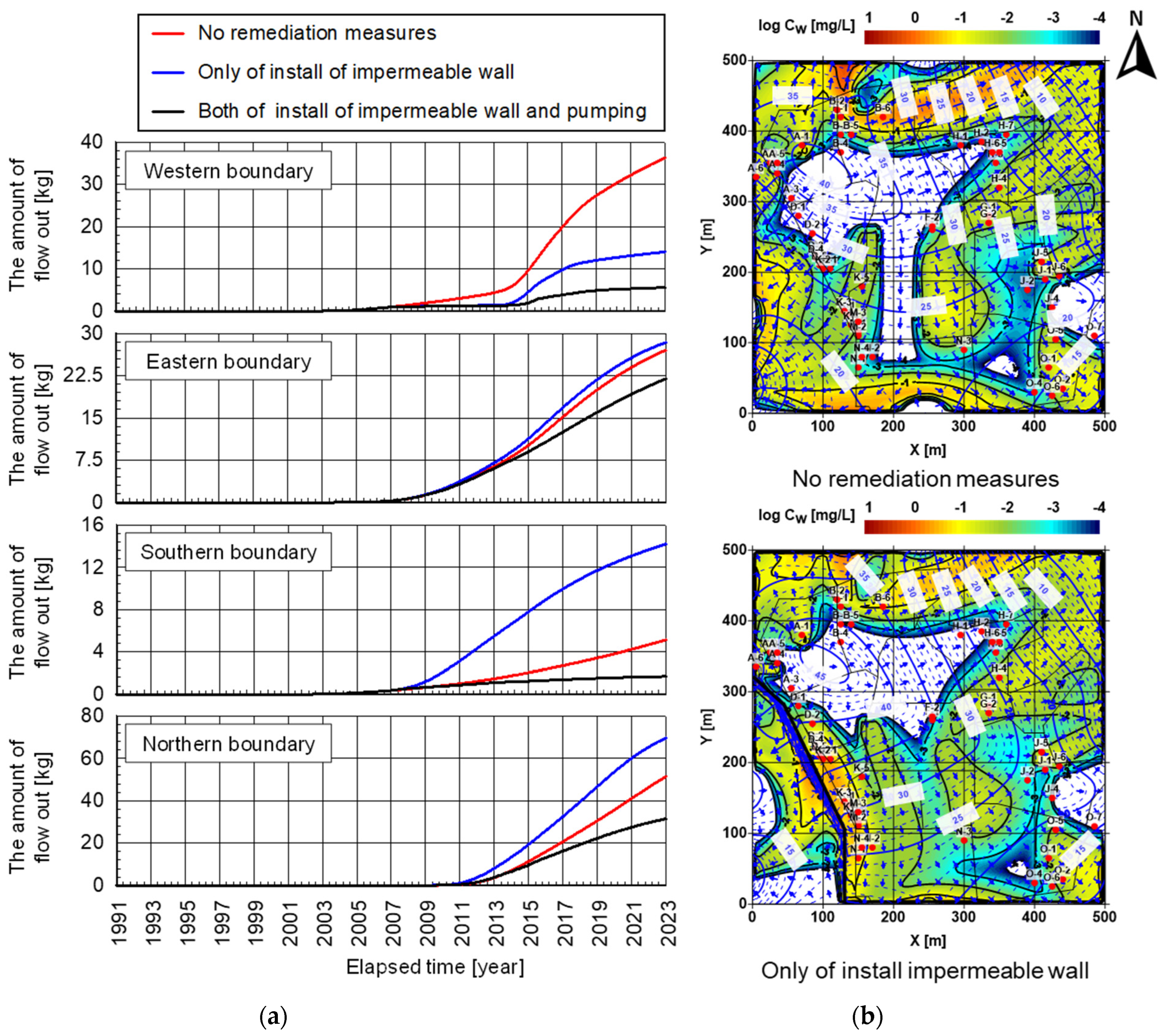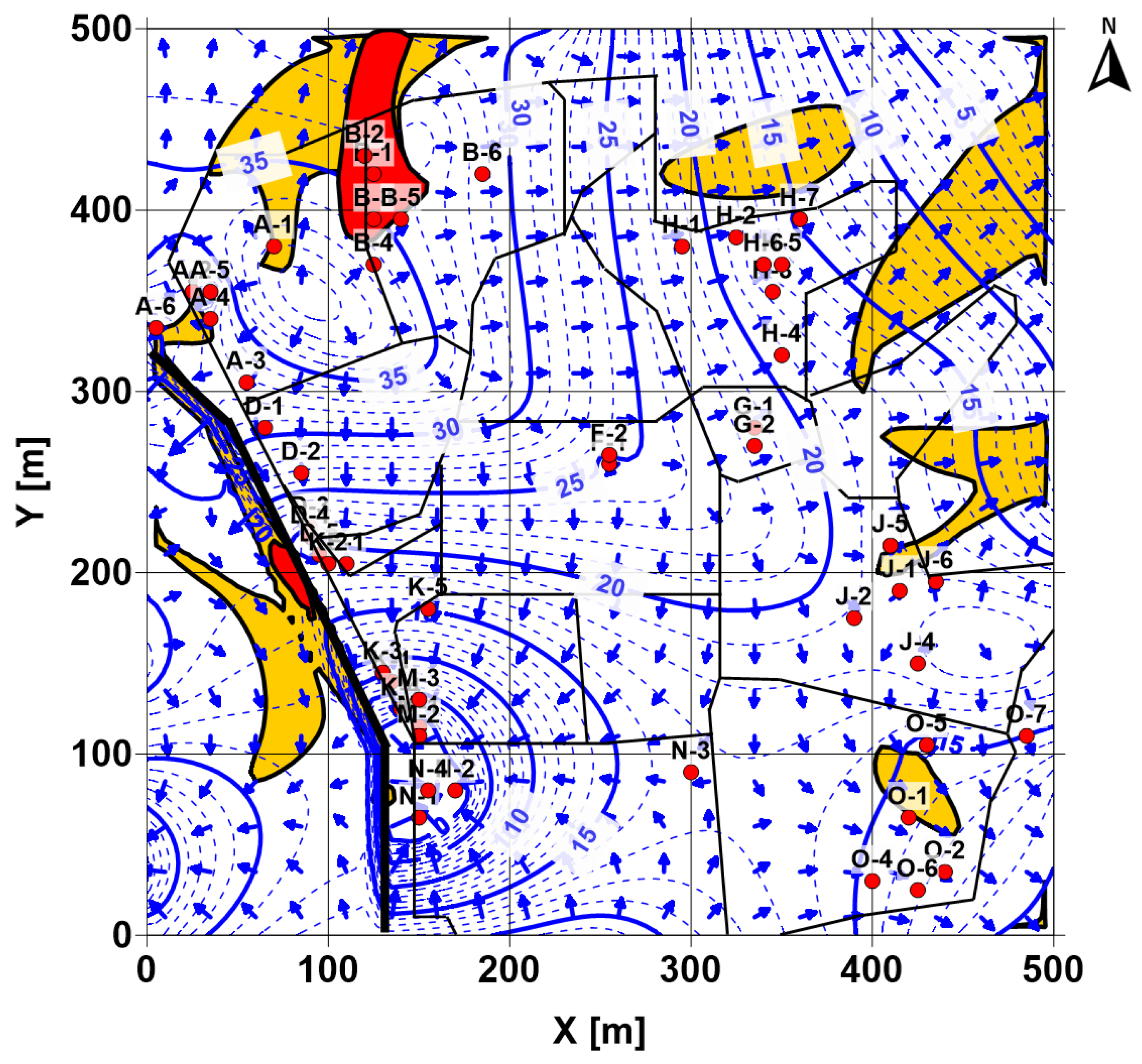The simulation period was set from January 1991, when the company started composting industrial waste at the site, to December 2022 (32 years). Based on the reproduced contamination situation, the effects of the impermeable wall on the control of contamination spreading and the remediation effect of pumping water were studied. The details of the calculation conditions are described below.
3.1. Spatio-Temporal Interpretation of Contamination Spreading Behavior across the Site
Prior to history matching, a preliminary analysis of the temporal and spatial spreading behavior of the contamination with changes in the distribution of the groundwater level caused by the installation of the impermeable wall and pumping was performed. According to the actual remediation results in November 2012 (
Figure 2), several 20 × 20 m
2 contamination sources were placed in areas D, E, G, J, N, and O, as shown with red boxes in
Figure 3. As the excavation at the western boundary of Area A and at the boundaries of Areas A and B has been removed since 2014, contamination sources were also placed in the corresponding locations. The amount of 1,4-dioxane inflow
at each contamination source was set to 10 kg. The numerical treatment of the inflow of 1,4-dioxane follows Equation (14).
The groundwater flow behaviors of the site can be divided into four main stages, corresponding to changes in the boundary conditions induced by the remediation measures: (1) installation of the impermeable wall (March 2007) and the start of pumping (September 2007), (2) operation of pumping aeration treatment in area N (July 2009), (3) start of pumping in the entire area as remediation measure of 1,4-dioxane contamination (April 2013), and (4) extension of the impermeable wall (July 2014). Based on a comparison of the groundwater level distribution and the spreading behavior of the contamination plume shown in
Figure 3, the site-wide spreading behavior as a function of changes in the groundwater level distribution can be interpreted as follows.
(1) The spread of the contamination plumes through December 2006 is due to the initial distribution of groundwater levels. Groundwater flows primarily in two directions: to the southwest and to the northeast, bounded by a watershed that crosses the site from northwest to southeast. Accordingly, plumes spread to the southwest in Areas A, D, and E; to the northeast in Area G; and to the southeast in Area O. Furthermore, since Area E is downstream of Area D, the plume originating from Area D overlaps with that of Area E. In Areas B, J, and N, however, the plume spreads in two different directions, depending on the local distribution of flow direction within the areas: to the north and east in Area B, to the northeast and southeast in Area J, and to the southwest and southeast in Area N.
(2) The May 2009 distribution shows that with the construction of the impermeable wall and that the start of pumping near the wall, the groundwater flow direction along the impermeable wall in areas D, E, and M changed from southwest to south. The contamination plumes originating from Areas D, E, M, and N overlap near the boundary between Areas M and N. In contrast, the effect of the impermeable wall and pumping on the flow direction in Areas B, G, J, and O is relatively small. Thus, the spreading direction of the contamination plume did not change significantly. In Area A, the plume continued to spread to the southeast because the impermeable wall had not been extended.
(3) In December 2009, when the pumping and aeration treatment was conducted in the N area, a hydraulic gradient toward the inside of the site was generated from the southern boundary of the N area, and the spreading direction of the plume was shifting toward the north. In addition, the influx of groundwater from the outside is expected to have a dilution effect on the 1,4-dioxane concentration at the site. On the other hand, no significant change was observed in the distribution of flow direction or spread of contamination across the site, compared to (2).
(4) In June 2014, after water pumping in the entire area had started, the hydraulic gradient near the boundary between the M and N areas increased with the increase in pumping near the impermeable wall, and the extent of the plume tended to increase in that direction.
(5) In January 2018, after the extension of the impermeable wall, the distribution shows that the flow direction in Area A has changed and the plume has partially spread along the impermeable wall toward the southeast. In addition, in Area O, which is downstream of Area N, the plume originating from Area N partially overlaps with the plume in Area O.
Although the 1,4-dioxane concentrations in Areas F and H were above the standard in May 2010, each well is outside the area where the contamination plume is spreading, as shown in
Figure 3. Based on the flow direction distribution as of December 2009, it is difficult to explain why F-2 (
= 255 m and
= 265 m) exceeded the standard, as the range for remediation in area F is
= 190–220 m and
= 230–250 m, as shown in
Figure 2. In area F, groundwater flows from the northwest and discharges mainly in the south direction, with some discharging to the northeast. Since the possibility of contamination spreading from private land located north of area F is extremely low, the exceedance of the standard in F-2 can be interpreted to be due to surface contamination in its vicinity, and the contamination plume originating from area F is expected to overlap downstream of area G. In addition, area H exceeded the standard, which is located downstream of both area B and private land. Thus, the possibility of contamination spreading from private land is extremely low. Furthermore, depending on the location of the contamination source in area B, there is a possibility that the contamination plume could reach area H. However, H-1 (
= 295 m,
= 380 m), the most upstream well on the streamline from area B, has maintained below-standard concentrations throughout 2013–2021, unlike other wells in the same area. Therefore, as in Area F, the exceedance of the standard may be due to surface soil contamination in this area, although no implementation of remediation measures was reported in November 2012.
It is usually necessary to consider the spreading of the contamination plume across areas in the matching of 1,4-dioxane concentration changes. However, based on the observed site-wide plume spreading behavior, conducting matching based on the area-specific interpretation of contamination is possible because there is a low possibility of inflow from another area for areas A, F, H, and J. In other areas, however, a gradual matching process is required, taking into account the concentration changes due to the influx of 1,4-dioxane from upstream, for instance, from area A to D and from area D to E. In particular, for areas M and N, the spread of the contamination plume from several directions in the surrounding area must be taken into account.
3.2. History Matching of Spatial-Temporal 1,4-Dioxane Concentration Changes for Area A
We use Area A here as an example to show the progression of changes in 1,4-dioxane concentration in this study because for Area A, the possibility of influx of the 1,4-dioxane from other areas is very low, and the effects of spreading contamination from other areas can be virtually ignored. To establish the boundary conditions for the inflow of 1,4-dioxane into the aquifer, the correlation between the change in the distribution of groundwater flow direction and the effects of the remedial action was first interpreted based on the monitoring results of 1,4-dioxane concentration for each pumping well in Area A and the calculated groundwater level distribution shown in
Figure S6.
In A-4 ( = 35 m, = 340 m), the concentration had been above ten times higher than the environmental standard (0.05 mg/L) for more than three years since the start of monitoring in April 2013. Nevertheless, after the excavation and removal of the contaminated soil near the western boundary in December 2016, a significant decrease in the concentration was confirmed. Therefore, the inflow of 1,4-dioxane into the aquifer after this date is interpreted as a converging trend. Corresponding to this actual result of the remedial action, the area around the western boundary, including A-4, can be considered a source of contamination (source of inflow to the aquifer), which is referred to below as CSA-1. In Area A, an extension of the impermeable wall was constructed in July 2014 to prevent contamination on the side of Aomori Prefecture. The groundwater level distribution shows that before the extension of the impermeable wall in January 2014, groundwater flowed mainly in the southwest direction around A-4 while turning to the A-6 side ( = 5 m, = 335 m) in the west direction after the extension (January 2015). The concentration at A-6 was 0.018 mg/L in August 2014 but has since increased to above the standard, which could be interpreted because of the change in the flow direction caused by the extension of the impermeable wall, and the contamination plume that spread in the direction of A-6 originated from CSA-1.
On the other hand, the increase in concentration at A-2 ( = 25 m, = 355 m) after April 2013 is unlikely to have originated from CSA-1, considering its locational relationship with A-4 and the difference in contamination levels between them, in addition to the groundwater flow direction in January 2014, suggesting the existence of another contamination source just near A-2. This contamination source is referred to as CSA-2. In CSA-2, the inflow into the aquifer can be considered to have started around April 2013, corresponding to the trend of an increase in concentration at A-2. In addition, remediation measures by pumping began in August 2015 at A-5 ( = 35 m, = 355 m), which is located immediately adjacent to A-2. The distribution of groundwater levels since pumping began shows the formation of a hydraulic gradient from the surrounding area toward A-5 (January 2016). The decrease in concentration in A-2 since November 2015 is interpreted mainly as a result of remediation measures by pumping. After that, the decrease has become remarkable since January 2017, suggesting that the inflow from CSA-2 has been a converging trend since then.
In A-1 ( = 70 m, = 380 m), which is the only well located across the watershed in area A. The concentration had already exceeded the standard in April 2013, and although it showed a slight downward trend after 2016, the concentration level remained above the standard. In May 2020, a chemical treatment method was applied in the central area of area A, and a significant decrease in concentration was confirmed after this period. According to the actual results of these remediation measures, the area near the center of area A could be regarded as the third contamination source, referred to as CSA-3. Based on the concentration change in A-1, it is interpreted that the inflow from CSA-3 into the aquifer ceased after May 2020. The distribution of groundwater levels shows that the water level is highest near the center of this area, and the streamlines radiate to the directions of A-2~A-5 in addition to the direction of A-1 on the north side. A-2 is located on the streamline westward from the center. However, the concentration at A-2 was 0.29 mg/L in October 2014, while that at A-1 was 0.12 mg/L. A-2, located downstream of A-1, according to the locational relationship with the central area, showed a higher concentration. Therefore, the presence of CSA-3 is expected to have little effect on the increase in the concentration of A-2. In addition, CSA-3 is expected to be located slightly on the side of A-1 across the watershed, where the spreading of the contamination plume toward A-2 and A-5 will have little effect. In addition, in A-3 ( = 55 m, = 305 m), a concentration of around 0.01 mg/L although below the environmental standards, has continued to be detected until 2022, possibly due to the spreading of the contamination plume to the south, which originated from CSA-3.
Based on the above discussion, for area A, history matching of 1,4-dioxane concentrations will be performed by placing three contamination sources: CSA-1 (near the western boundary), CSA-2 (just near A-2), and CSA-3 (near the central area). In the matching process, in addition to the locational relationship of the pumping well to each contamination source, the amount of 1,4-dioxane inflow
[kg], area of the contamination source
[m
2], inflow start time
[years after], and inflow end time
[years after] described in Equation (3) are treated as parameters. For the inflow end time
, the values could be set based on concentration changes and actual results of the remediation measures, namely, December 2016 for CSA-1 and CSA-2, and May 2020 for CSA-3. The inflow start time
of CSA-2 was set in April 2013, at which the concentration of A-2 increased. As for CSA-1 and CSA-3, the
should be set to an earlier time because the concentrations of A-1 and A-4, which are in the vicinity of CSA-1 and CSA-3, had already increased in April 2013. However, it was difficult to determine
only from the changes in concentrations. On the other hand, a survey conducted in 2009 for the entire site, when 4-dioxane was included as a new environmental criterion, did not detect contamination in Area A. Therefore, the spreading of contamination into the aquifer originating from CSA-1 and CSA-3 could be regarded as occurring after 2009, and
was assumed to be January 2013 for CSA-1 and January 2012 for CSA-3, respectively. Multiple repeated preliminary analyses were conducted to determine the detailed condition setting of the contamination source area
and its locational relationship with the pumping wells; however, these analyses will not be described here for space limitations. The calculation conditions for this matching process are shown in
Table S1. The matching process consists of three steps: Step.1: CSA-1, Step.2: CSA-2, and Step.3: CSA-3, in which the amount of 1,4-dioxane,
, at each contamination source is appropriately changed in that order. The details of the history-matching process are described below.
3.2.1. Step 1: Placement of Contamination Source CSA-1 near the Western Boundary of Area A
In the first step, the contamination source CSA-1 was placed near the western boundary of area A. Then, the monitoring results were compared with the calculation results using the concentration changes at A-4 and A-6 as indicators. CSA-1 was placed in the range of = 25 to 40 m and = 325 to 340 m, including A-4, with an area of 225 m2, so as to locate A-6 on the west side of CSA-1, because the flow direction to the southwest near A-4 turned to the west toward A-6 after the impermeable wall was installed. The period of inflow of 1,4-dioxane into the aquifer in CSA-1 was set to four years, from January 2013 to December 2016, when a significant decrease in concentration was observed in A-4 due to excavation removal. The analysis was conducted by changing the amount of 1,4-dioxane inflow, , in four cases: Case-01: 5.00 kg, Case-02: 10.0 kg, Case-03: 20.0 kg, and Case-04: 40.0 kg.
As representative calculation results,
Figure 4a shows that the 1,4-dioxane concentration and groundwater level distribution change over time for Case-02, where
is 10.0 kg. The location of CSA-1 is shown in the red box in the figure. The July 2013 and January 2014 distributions show that prior to the extension of the impermeable wall, the contamination plume originating from CSA-1 spread in the same direction as groundwater flow in the region, including CSA-1 and its downstream side. After the extension of the impermeable wall, the direction of the plume spreading turned to the west, as shown for January 2015, which corresponds with the westward shift of the flow direction near CSA-1, and an increase in the concentration near A-6 was observed. In addition, the distributions in January 2016 and 2017 show that the plume spread toward A-2 and A-5 north of CSA-1 after pumping at A-5, as a hydraulic gradient formed toward A-5. Between CSA-1 and A-6, the trends of plume spreading to the west are stronger, and the concentration near A-6 remains at a high level. Because the CSA-1 site also includes A-4, the concentration near A-4 will remain high as long as inflow from CSA-1 into the aquifer continues. However, by January 2018, the inflow to the aquifer had ceased; as a result, a significant decrease in concentration near A-4 was recognized. A general downward trend was observed at A-5 due to the dilution effect from groundwater flow in addition to pumping remediation.
Figure 4b compares the calculated concentration changes over time at each pump well determined for cases-01 through 04 with the monitoring results. Corresponding to the changes in concentration distribution shown in
Figure 4a, the concentrations in A-4 remained beyond the environmental standard for four years after January 2013 and decreased significantly with the end of the inflow in December 2016, while the concentrations in A-6 increased after 2013 and decreased after 2018. These calculations reflect well the trend of concentration change shown in the monitoring results. Furthermore, in Case-02, where
is set to 10.0 kg, the concentration in A-4 and A-6 are the closest to the monitoring results. Based on the results of Case-02, to validate the above interpretation that the increase in concentration at A-6 was due to the spreading of the contamination plume originating from CSA-1, we conducted a series of analyses by varying the placement of CSA-1, the inflow period, and the adsorption coefficients.
As shown in
Figure 5a, the source placement varied from
= 25 to 40 m and
= 325 to 340 m in Case-02, to
= 20 to 35 m and
= 340 to 355 m on the north side along the district boundary in Case-05, and
= 30 to 45 m and
= 310 to 325 m on the south side along the area boundary in Case-06, finally to
= 35 to 50 m and
= 325 to 340 m further inside the area boundary in Case-07. The analysis was conducted with
and the inflow period set equal to those in Case-02, and the results were compared with the monitoring results using A-4 and A-6 as indicators, as shown in
Figure 5b.
In Case 05, the contamination plume reached the site of A-6 earlier due to the southwestern groundwater flow before the extension of the impermeable wall, and the trend of the concentration increase after 2013 is significant; with the change of the dispersion direction of the plume due to the change of the flow direction after the extension, the concentration decrease occurred as early as the second half of 2015, resulting in a significant difference from the monitoring results. In case 06, the concentration increase in A-4 cannot be reproduced because A-4 is not included within the range of CSA-1. In addition, the spreading direction of the contamination plume was different, and the concentration in A-6 remained more than an order of magnitude lower than the monitoring results. In Case-07, the distance between CSA-1 and A-6 was greater than in Case-02, and the timing of the concentration increase was delayed due to the delay in the arrival of the contamination plume at the position of A-6. Based on the above results from Case-05 to Case-07, the placement of CSA-1 in Case-02 is considered appropriate. This supports the interpretation that the increase in concentration at A-6 is due to the spread of the contamination plume originating from CSA-1.
To verify the inflow period, Cases 08~10 were tested with CSA-1 and
equal to those in Case-02. In Case-08, Case-09, and Case-10, the period of inflow was set from January 2011 to December 2016 (6 years), from January 2015 to December 2018 (4 years), and from January 2013 to December 2014 (2 years), respectively. Case-08 assumes an early spreading of contamination, Case-09 assumes a later spreading, and Case-10 assumes an early excavation removal compared to Case-02 (January 2013 to December 2016). The obtained results in the different cases of the period of inflow are shown in
Figure 6 and are compared with the monitoring data using A-4 and A-6 as indicators.
In Case-08, the concentration of A-6 had already exceeded the standard in early 2012, which is different from the monitoring results. In Case-09, the concentration changes to exceed the standard in the two years by 2015 could not be well reproduced in either well. In addition, because the inflow of 1,4-dioxane to the aquifer continued after December 2016, there was a delay in the decrease in concentration, resulting in a significant difference from the monitoring results. In Case 10, since the inflow to the aquifer stopped after January 2016 due to excavation and removal, it is impossible to reproduce the concentration changes that have been above the standard since 2016. Based on the above results for Cases 08 through 10, under the assumption that the placement of CSA-1 is appropriate, the condition of four years of inflow from January 2013 through December 2016 can be considered appropriate, indicating that the spread of contamination into the aquifer originating from CSA-1 occurred relatively recently.
Furthermore, as described in
Section 2.2 (2), considering the relatively low adsorptive of 1,4-dioxane in the sandy soil, the adsorption coefficient
for a series of numerical analyses was set to 1.00 × 10
4 m
3/kg instead of 7.88 × 10
4 m
3/kg that were obtained experimentally. A validation of this
value was also conducted using the same 1,4-dioxane inflow condition of Case-02, and the
values were changed in four steps, Case-11: 7.88 × 10
4 m
3/kg (corresponding to the experimental value), Case-12: 5.00 × 10
4 m
3/kg, Case-13: 5.00 × 10
3 m
3/kg and Case-14: 0.00 × 10
0 m
3/kg (without consideration of adsorption) with respect to 1.00 × 10
4 m
3/kg for Case-02, respectively. The results obtained and the comparison with the monitoring results are shown in
Figure 7. In cases 11 and 12, 1,4-dioxane had a higher absorption capacity than in case 02, and the amount of 1,4-dioxane retained on the surface of soil particles as the adsorbent increased, resulting in delayed advection and dispersion in the aquifer. As a result, the concentration at A-4 after excavation and removal in January 2017 is declining slowly, and the timing of the concentration increase at A-6 is also delayed. In contrast, in Cases 13 and 14, the amount of 1,4-dioxane absorbed was lower, and the mobility of 1,4-dioxane due to advection and dispersion in the aquifer increased, resulting in a significant decrease in concentration in both wells compared to the monitoring results. The above results suggest that the adsorptive of 1,4-dioxane to the soil is low but has a certain level of adsorptive and that the use of a
value of around 1.00 × 10
4 m
3/kg best reproduced the plume spreading behavior caused by advection and dispersion.
Based on the above validity verification of the placement of CSA-1, the inflow period, and the adsorption treatment, a comparison of the calculated and monitored concentration changes at A-1, A-2, A-3, and A-5 is made in
Figure 4. Since A-1 and A-3 are independent of changes in groundwater flow direction and are outside the range of contamination plume spreading originating from CSA-1, it is difficult to reproduce the concentration changes in these wells. On the other hand, A-2 and A-5 are not located in the main direction of spreading the contamination plume, so the increase in concentration in these wells can be interpreted as due to pumping at A-5. In particular, at A-2, the difference between the calculated results and the monitoring results in terms of the concentration level and the timing of the concentration increase is so large that the effect of CSA-1 on the concentration increase at A-2 is very small. This result provides a basis for considering CSA-2 as a separate source of contamination from CSA-1 to reproduce the concentration change in A-2. In addition, based on the results of the study in Step 1, the conditions in Case-02 that best reproduce the concentration changes in A-4 and A-6 are used in subsequent Steps 2 and 3 for the conditions related to CSA-1.
3.2.2. Step 2: Placement of Contamination Source CSA-2 to the Vicinity of A-2
In Step 2, CSA-2 is newly placed in addition to CSA-1 in Step 1, using the changes in the concentrations of A-2 and A-5 as indicators to reproduce the monitoring results. A-2 and A-5 are only 10 m apart in the direction, and both wells were located almost on the same streamline to the west direction with A-5 upstream with respect to A-2 before the start of pumping at A-5. Concentration levels were generally higher in A-2, which was located downstream. Therefore, we performed a series of preliminary analyses to determine the placement of CSA-2 under the condition that CSA-2 should have little effect on the concentration increase of A-5 and should be located just near A-2. As a result, the contamination source area is set as 100 m2 (10 × 10 m) and is placed in the range of = 20 to 30 m and = 360 to 370 m to the north of the vicinity of A-4. The period of inflow of the 1,4-dioxane from CSA-2 into the aquifer was defined as 3.75 years, from April 2013, when the concentration in A-2 started to increase, to December 2016, when a significant decrease in concentration was observed, according to the monitoring results. The analysis was conducted by changing the amount of the 1,4-dioxane inflow during this period in four steps: Case-15: 1.00 kg, Case-16: 2.00 kg, Case-17: 5.00 kg, and Case-18: 10.0 kg.
As an example of the calculation result, the changes of 1,4-dioxane concentration and groundwater level distributions with time obtained for Case-16 when
was set to 2.00 kg, is shown in
Figure 8a. The distributions in July 2013, January 2014, and January 2015 show that before the start of pumping at A-5 in August 2015, there was no significant change in the flow direction near A-2 and A-5 before and after the extension of the impermeable wall; the contamination plume spread mainly toward the southwest side. According to the positional relationship with CSA-2, A-5 is outside the main spreading direction of the plume, and the increase in concentration at A-5 is probably mainly due to dispersion. From the January 2016 distribution, after the start of pumping at A-5, a hydraulic gradient developed from A-2 toward A-5, and the further spreading of the plume was controlled by pumping. Since January 2017, since the inflow from CSA-2 into the aquifer has stopped, concentrations near A-2 and A-5 will decrease over time as pumping continues at A-5. A-1 and A-3 are outside the area where the contamination plume from CSA-2 is spreading, regardless of the change in groundwater flow direction.
Figure 8b compares the monitoring results with the concentration changes over time in each pumping well obtained in Case-15–18. The results from Case-02 are also shown in this figure. Prior to pumping in April 2015, concentrations in A-2 had been gradually increasing since April 2013 and were beyond environmental standards, while concentrations in A-5 remained below standard, although a slight increase was observed. The change in concentration in A-5 during this phase is consistent with the interpretation of the concentration distribution shown in
Figure 8a, which is due to the lateral spread of the contamination plume. A significant increase in the concentration in A-5 was observed with the start of pumping, and the concentration in A-4 also increased once, depending on the spatial relationship with CSA-2.
After that, with the end of 1,4-dioxane inflow from CSA-2 to the aquifer in December 2016, the concentrations in both wells showed a decrease. This trend of concentration changes is regardless of , and indicate that the monitoring results have been well reproduced. Especially for Case-16, with of 2.00 kg, the calculated results show that concentration levels in A-2 and A-5 are closest to the monitoring results. It also confirms that the spreading of the contamination plume originating from CSA-2 has little effect on the concentration change in A-6, which is located downstream. Based on the above results in Step 2, in addition to the conditions obtained in Case-02 for CSA-1, the conditions obtained in Case-16, which best reflect the concentration changes in A-2 and A-5, are adopted in Step 3 for the set of conditions for CSA-2.
3.2.3. Step 3: Placement of Contamination Source CSA-3 near the Center of Area A
In step 3, we performed the analyses with the newly placed CSA-3 in addition to CSA-1 in step 1 and CSA-2, using the concentration changes in A-1 and A-3 as indicators as well. From the monitoring results, after the chemical treatment in the central part of Area A corresponding to CSA-3 was conducted in May 2020, a significant decrease in the concentration in A-1, which is close to CSA-3, was observed. According to the monitoring results and groundwater level distribution shown in
Figure S6, based on the interpretation that the presence of CSA-3 has little effect on the concentration change at A-2 and A-5, and the increase in concentration at A-3 is caused by the southward advection and dispersion originating from CSA-3, through multiple repeated preliminary analyses, the CSA-3 area
was set to 400 m
2 (20 × 20 m) and placed in the range of
= 65 to 85 m and
= 355 to 375 m across the watershed just near A-1. The period of 1,4-dioxane inflow from CSA-3 to the aquifer was assumed to be 8.4 years, from January 2012 to May 2020, when a significant decrease in concentration at A-1 was confirmed by the application of the chemical method. The analyses were conducted by changing the amount of 1,4-dioxane inflow
in four steps: Case-19: 3.00 kg, Case-20: 6.00 kg, Case-21: 12.0 kg, and Case-22: 24.0 kg.
As a representative result,
Figure 9a shows the changes in the 1,4-dioxane concentration and groundwater level distribution over time obtained for Case-20 when
is set to 6.00 kg. Before and after the extension of the impermeable wall in July 2014 and the startup of pumping at A-5 in April 2015, the distribution of radial groundwater flow directly from the center of Area A did not change significantly. Accordingly, the area where 1,4-dioxane concentrations increased spread over time. Both A-1 and A-3 were contained in this area in January 2013. This is especially true since the concentration on the north side of CSA-3 is higher, indicating that the contamination plume originating from CSA-3 spreads mainly toward A-1 on the north side.
Figure 9b compares the monitoring results with the concentration changes over time in each of the pump wells obtained in Cases 19 through 22. This figure shows that the concentration in A-1 was beyond environmental standards for eight years beginning in January 2012, and then decreased significantly with the end of inflow to the aquifer in May 2020. In addition, an increase in concentration was observed in A-3 due to the advection and dispersion of 1,4-dioxane over a large area in Area A (see
Figure 9a). Compared to Case 16, the increase in A-5 occurred earlier in Cases 19 through 22, and the decrease in concentration in each well after the cessation of 1,4-dioxane inflow from each contamination source was relatively slower. However, the concentrations change at a lower level than the standard. Thus, the effect of advection/dispersion from CSA-3 on the concentration changes in A-2, A-4, A-5, and A-6 can be considered relatively small. These whole behaviors are common regardless of the
, and the trend of concentration change obtained from monitoring results is well reproduced. The results of Case-20, with
value of 6.00 kg, showed the best matching with monitoring results for concentration levels in A-1 and A-3.
Based on the results of Steps 1 to 3, the final matching of spatial-temporal changes in 1,4-dioxane concentrations in the aquifer for area A was made based on the calculation conditions of Case-20 slightly by adjusting the amount of 1,4-dioxane inflow
and the inflow period for better reproducing. In the series of analyses, the boundary conditions for the termination of inflow into the aquifer were given based on the actual results of remediation measures. However, since the decrease in concentration in the monitoring results is slower compared to the results of Case-20, it is supposed that the inflow into the aquifer may continue, although only slightly. Therefore, the boundary condition should be newly defined for subsequent inflow. In addition, the distribution of
within each contamination source, and its time variation was also partially considered to better reproduce the concentration changes at each pumping well. Moreover, to reproduce the rapid decrease in concentration just after April 2013 at A-3, CSA-4 was placed as an additional contamination source at
= 55–65 m and
= 305–315 m upstream of A-3. The conditions for the inflow of 1,4-dioxane into the aquifer at each contamination source are shown in
Table 4.
Furthermore, we interpreted that the remediation measure to the aquifer, in addition to surface soil by application of chemical treatment, had also been achieved based on the rapid decrease in concentration after May 2020 in A-1 and introduced the attenuation rate by Equation (17) within the range of CSA-3 for better reproducing of concentration change in A-1. The final matching results for area A are shown in
Figure 10.
3.3. Validity of the Simulation Results and Evaluation of the Effectiveness of the Impermeable Wall and Pumping
According to the history matching process described in the previous sections and taking into account the major remediation activities conducted since 2014 at the boundaries of Areas A and B, the history matching for the changes in 1,4-dioxane concentrations throughout the area was also conducted by defining the surface contamination sources in other areas. The changes in the 1,4-dioxane concentration, the distribution of groundwater levels, and the results of the history matching for each pumping well are also shown in
Figure 11. The contamination plume spread behavior in each area follows the interpretation of
Figure 3. Even for the location where multiple contamination plumes occur, such as M-2 (
= 150 m,
= 110 m) and N-1 (
= 150 m,
= 65 m), the changes in the concentrations can be well reproduced.
The measured and calculated amounts of total 1,4-dioxane recovery for the period from April 2013 to March 2014, when total 1,4-dioxane recovery by pumping was recorded, are compared in
Figure S7. The measured total recovery in February 2014 was 7.37 kg, while the calculated total recovery was estimated to be 8.64 kg, which generally reflected the trend of increased recovery of 1,4-dioxane by pumping. The calculated results of the distribution of 1,4-dioxane concentrations at the site, at least in April 2013, when pumping began throughout the area, reflect the actual contamination situation, both temporally and spatially. Thus, the reliability of the historical matching was confirmed, and the calculated results were considered fully applicable for quantitative assessment of remedial actions, as well as for prediction of future contamination levels. The amount of 1,4-dioxane inflow
[kg], contamination source area
[m
2], the start time of inflow
[years after], and the end time of inflow
[years after] for each contamination source obtained from the history matching for the whole area are listed in
Table S2. Based on the specified contamination source parameters listed in
Table S2, additional analyses were conducted under the following conditions: (1) no remediation (no installation of an impermeable wall and no pumping) and (2) installation of an impermeable wall only (no pumping). The effectiveness of the impermeable wall in preventing the spread of contamination and pumping out water as a remediation measure is then verified by comparing it to the case with the remediation measures shown in
Figure 11.
Figure 12 shows the changes over time in 1,4-dioxane inflow and recovery by pumping, 1,4-dioxane remaining in the area, 1,4-dioxane discharged from the boundary, and the area in which the environmental standard is exceeded.
Based on the inflow conditions shown in
Table S2, the amount of 1,4-dioxane flowing into the aquifer at the end of 2022 was 174 kg, while the amount recovered by pumping was 85.3 kg, with a recovery ratio of about 49.0%. The remaining amount in the aquifer decreased from a peak of 92.7 kg in September 2014 to 27.4 kg at the end of 2022 due to pumping measures. The area above the standard (0.05 mg/L) was correspondingly reduced from 64,400 m
2 to 29,150 m
2, less than half due to remediation measures. In the case without remediation measures, the remaining amount of 1,4-dioxane at the end of 2022 was 56.2 kg, and the area above the standard was 55,650 m
2. Thus, it was confirmed that the remediation measures have a twice effect on the decrease in the concentration of 1,4-dioxane. However, comparing the case without remediation measures with the case where only the impermeable wall was constructed, the amount of 1,4-dioxane flowing out of the site at the end of 2022 was estimated to be 120 kg and 126 kg, respectively, showing that the construction of the impermeable wall unexpectedly promoted the spreading of 1,4-dioxane and its runoff from the site.
Figure 13a compares the outflow amount at each boundary over time. The amount of runoff on the western boundary decreased from 36.2 kg to 13.8 kg at the end of 2022 due to the installation of an impermeable wall, indicating that the wall was very effective in preventing the spread of contamination to the Aomori Prefecture side. However, at the same time, the discharge on the south side increased from 5.12 kg to 14.2 kg, and on the north side from 51.4 kg to 69.5 kg. The changes in groundwater direction shown in
Figure 13b indicate that the installation of the impermeable wall also caused a steep hydraulic gradient in the north and south directions. The installation of an impermeable wall without appropriate pumping measures would unexpectedly accelerate the spread of contamination.
Figure 14 shows the areas that exceed the standard and pose a health risk at the end of 2022 in the case of remediation measures. For health risk determination, groundwater was assumed to be consumed as drinking water, and the daily exposure [mg/kg/day] was calculated by dividing the cumulative exposure
[mg] by the exposure time, 32 years (
= 11,680 days), and body weight
[kg]. In Japan, there is no standard value for chronic toxicity, and 0.05 mg/L corresponding to the environmental standard is taken as a temporary reference value. Therefore, the daily exposure amount per 1 kg of body weight is divided by the oral reference dose (
[mg/kg/day]) according to the U.S. EPA [
33], which is defined as the risk level, and when the risk level exceeds 1, it is judged as risky according to the following formula.
Here, the
value of 1,4-dioxane is 1.60 × 10
−2 mg/kg/day, and the
and daily water intake are set to 50 kg and 2 L/day, respectively, according to the Ministry of Health, Labor and Welfare and Environment Agency (Japan) [
34]. As the figure shows, almost the entire area within the site has been remediated below the environmental standard by the end of 2022. In addition, it has been reported by Iwate Prefecture that the areas on the north side of Areas A and B and the off-site areas on the east side of Areas I and J have also exceeded the standard. Although not included in this analysis, Iwate Prefecture has taken additional measures to promote remediation. In addition, the area identified as having risk was limited to Area B and its north side, and even for areas exceeding the standard, the health risk was judged to be generally low, confirming the fact that the remediation measures taken by Iwate Prefecture were sufficient.
The history matching results using the developed model show good agreement with monitoring results, indicating this modeling process can be applied for the prediction of contaminant transport phenomena in groundwater at the site with multiple sources, and the source conditions change with remediation measures, which is a more realistic condition for most illegal dumping sites. This modeling process can also be used in the assessment of the effect of remediation measures and the planning of effective remediation. Furthermore, we supposed that the detailed process provided in this study would be effective for other researchers to follow when dealing with similar illegal dumping sites elsewhere.
